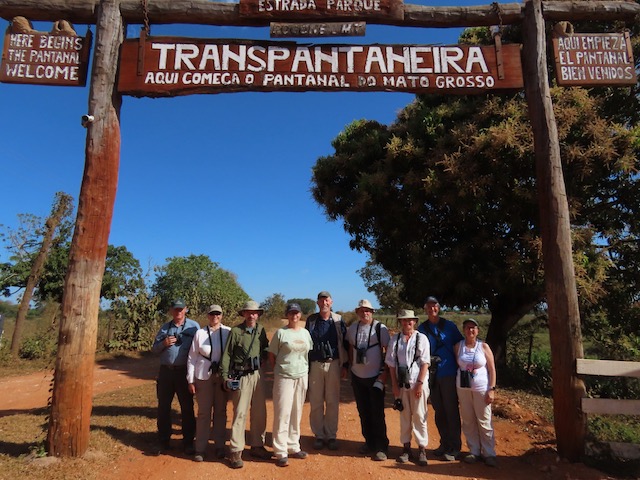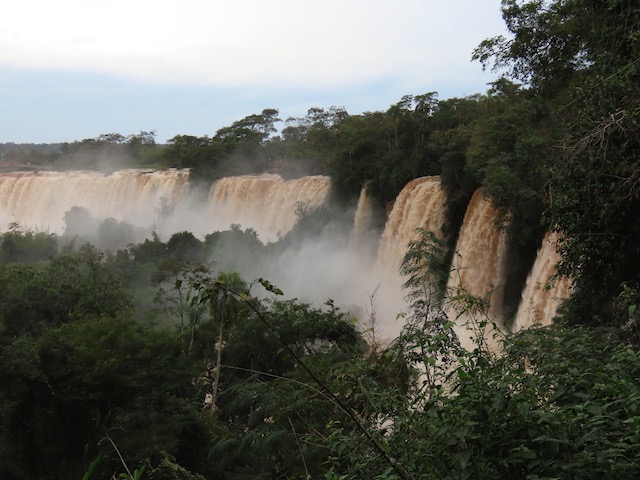Rich Hoyer has recently returned from Brazil
So many species, so many highlights, and so many wonderful memories were the result of this year's Marvelous Mato Grosso tour. For some, more than half of the over 500 species of birds we saw were lifers, while for others some exciting milestones were reached – 2000 for Dan Toweill and 6000 for Cathy Pasterczyk. Memorable bird sightings in the Chapada dos Guimarães National Park, where we started the tour, included Dot-eared Coquette, a very rare Chaco Eagle, our first of many handsome King Vultures, and amazing Red-legged Seriemas (the latter receiving many votes among the tour’s favorites).
We then moved on to Cristalino Lodge in the Amazonian north of the state, where the hands-down favorite of the tour was the Harpy Eagle perched quietly in a tree less than 50 meters from where we first had been distracted by a mob of tanagers, tyrannulets, flycatchers, and hummingbirds. We watched it for over 15 minutes, admiring it’s bushy crest and short, massively thick legs. Though jungle birding can be difficult, most of the tour’s favorites were at Cristalino – the Bare-eyed Antbirds at the bird bath; the Pompadour Cotinga and Curl-crested Aracaris from the towers; Eastern Striolated-Puffbird and White-necked Jacobin on the Serra; and the Bare-faced Curassows wandering the grounds near our rooms.
We saw some wonderful birds in the Pantanal as well, such as Southern Screamers with chicks, several Green-and-rufous Kingfishers, and the incredible Hyacinth Macaws, the latter a close second-favorite bird of the tour. But the Jaguars certainly stole the show this time, with eight unforgettable animals. It helped that we had a super skilled boatman named Marcelo Arruda, who also had sharp eyes for spotting large cats on the bank. Our group was the first to get photos of Ibaca’s second cub from last fall (it was thought that she had only one), so we got to name it – and we chose Ipepo, the Guaraní word for “wings.” But we also watched the rarely-seen event of a six-year-old Pixána catch a capybara; her 22 seconds under water has us filled with suspense and wonder. And then the finale was noticing two-year-old Kasimir only when he leapt up out of the water onto a fallen tree that was only 10 meters from our boat. Our second tour last year saw him with his brother and mother, over 12 miles away, so it was great to see him again, having set out on his own.
We finished the tour by adding another 70 species of birds in Misiones, Argentina, but the sight and sound Iguazú Falls after a period of heavy rains upstream was most impressive. The water flow was about three times average, and we had the great fortune of being there at the right time before an approaching cold front to watch an estimated 20,000 Great Dusky Swifts gather and disappearing behind the falls for their nightly roost. It was an unforgettable experience.
A pair of Red-and-green Macaws foraged on a small fruiting tree by the roadside in Chapada dos Guimarães.
Pearl Kite is not seen every year, so we were pleased to have seen eight individuals in the first three days of the tour.
A Pink-throated Becard at what seemed like arm’s length was possible only from our perch atop one of Cristalino’s two tours.
This Harpy Eagle was spotted because participant Stef McLaney looked in the opposite direction from the group of tanagers and flycatchers the rest of us were watching.
The size and blueness of Hyacinth Macaw has to be seen to be believed.
This handsome devil is Kasimir, seen for the first time on his own territory away from his brother and mother.

A very happy group after our time in the Pantanal.

Most of the group continued on the extension to witness the marvelous Iguazú Falls during a high water event.
